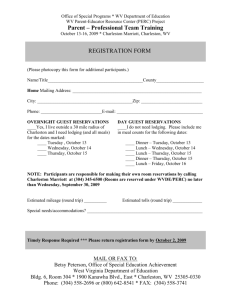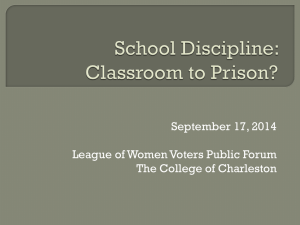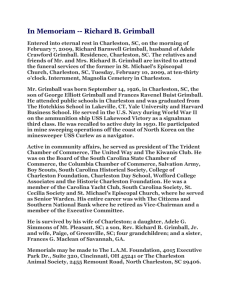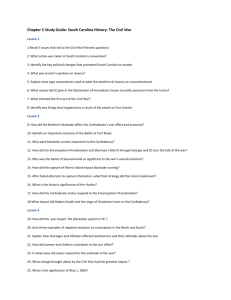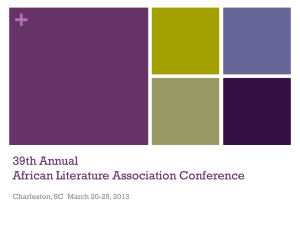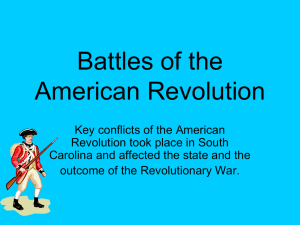File
advertisement
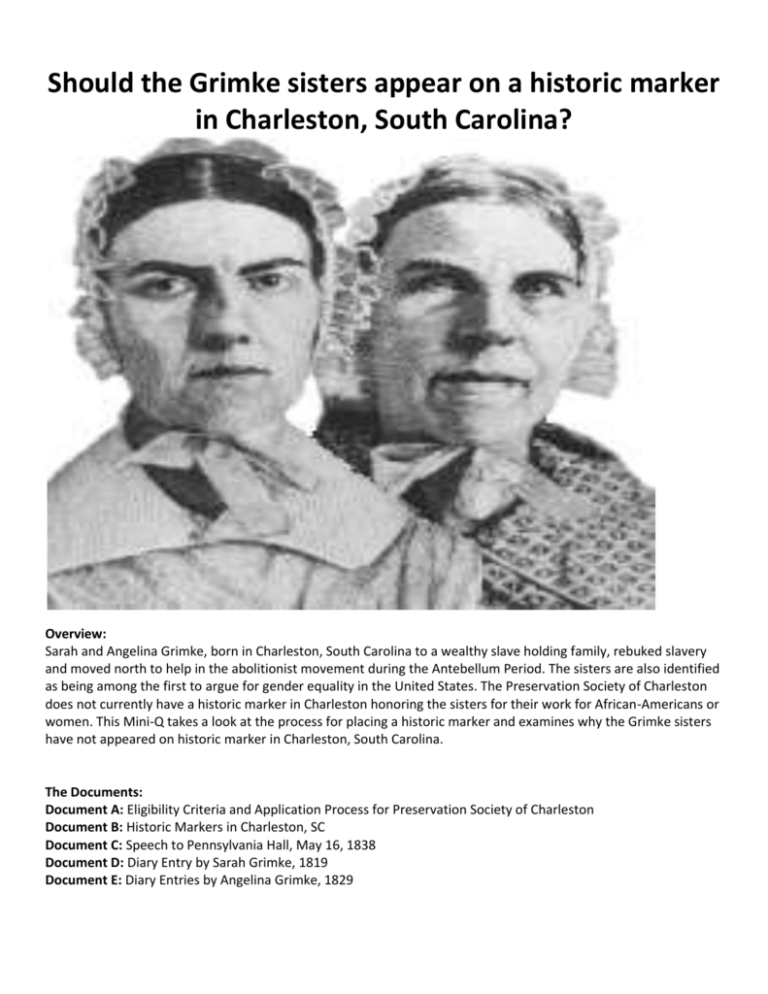
Should the Grimke sisters appear on a historic marker in Charleston, South Carolina? Overview: Sarah and Angelina Grimke, born in Charleston, South Carolina to a wealthy slave holding family, rebuked slavery and moved north to help in the abolitionist movement during the Antebellum Period. The sisters are also identified as being among the first to argue for gender equality in the United States. The Preservation Society of Charleston does not currently have a historic marker in Charleston honoring the sisters for their work for African-Americans or women. This Mini-Q takes a look at the process for placing a historic marker and examines why the Grimke sisters have not appeared on historic marker in Charleston, South Carolina. The Documents: Document A: Eligibility Criteria and Application Process for Preservation Society of Charleston Document B: Historic Markers in Charleston, SC Document C: Speech to Pennsylvania Hall, May 16, 1838 Document D: Diary Entry by Sarah Grimke, 1819 Document E: Diary Entries by Angelina Grimke, 1829 Hook Exercise: Historic Markers in South Carolina Introduction: A historic marker is a notification, such as a plaque or sign, to memorialize an event or person of historic interest and to associate that historic person or event with a location that may be visited by the general public. Many historical markers are placed by national or state agencies concerned with historic preservation. Other markers are placed by local non-profit organizations with a specific theme for a unique geographical region. The criteria and circumstances for placement of a historic marker is varied and often based on the political agendas of the organizations in charge. The historic people and events chosen for markers may or may not be the most historically significant and the information provided to the public could often be biased or inaccurate due to the economic base that provides funding for the plaques. Below are three examples of historic markers in South Carolina. Please examine the markers and answer 1.Read the Lord Cornwallis marker from Isle of Palms, South Carolina commemorating S.C. Ranger’s defeat of British troops in 1776 and the British victory in 1780 when Charles Town was captured. A. Is this a historic event that should receive a marker? Explain. 2. The Kaminski House marker from Georgetown, South Carolina honors the home of the former mayor and states the house was “probably built between 1730 and 1800.” A. Do you think that a more accurate record is necessary for a historic marker? 3. Read the Clifton Plantation marker located north of Georgetown, South Carolina honoring President George Washington’s visit and travels down modern Highway 17 (Kings Highway) in 1791. A. Is the location that a President slept one night historic? Why would a marker like this one be assigned? Background Information 321 East Bay Street in Charleston, South Carolina is referred to as the William Blake House, descendant of Landgrave Joseph Blake and one of the wealthiest slave owners in South Carolina and was donated to the Historic Charleston Foundation (HCF) in 1962. Now a law office, the house bears the placard declaring it a part of the Rehabilitation Project of the HCF and establishing it as the Blake Home built in 1789. Though the plaque does not mention it, the house was also owned by Judge John Faucheraud Grimke, an officer of the Continental Army during the Revolution. He was educated at Oxford and studied law in London. His fourteen children included Sarah and Angelina Grimke, early supporters of abolition and women’s rights. Sarah was the sixth child and Angelina was the youngest. Sarah said at age five, after she saw a slave being whipped, she tried to board a steamer to a place where there was no slavery. Later, in violation of the law, she taught her personal slave to read. Sarah wanted to become a lawyer and follow in her father’s footsteps. She studied constantly until her parents learned that she intended to go to college with her brother Thomas. They forbade her to study her brother’s books or any foreign language. Her father supposedly remarked that if she “had not been a woman, she would have made the greatest jurist in the land.” Sarah became Angelina’s godmother and quickly became disillusioned with life in slavedependent Charleston. She became involved with the Quakers and eventually moved North to be able to participate in the Abolitionist Movement. In 1835 Angelina followed her sister and both travelled throughout the North lecturing about their firsthand experiences with slavery on their family’s plantation. Among the first women to act publicly in social reform movements, they were ridiculed and ostracized for their abolitionist and women’s rights activity. They were among the first American reformers to compare the condition of women to the plight of enslaved Africans and to call for an end to the exploitation based on both race and gender. When William Lloyd Garrison published a letter from Angelina in his abolitionist journal, The Liberator, they gained notoriety as being the first female abolitionist to speak out. The sisters were heavily criticized by both the North and South for speaking publicly about their beliefs but criticism in Charleston was particularly scathing. As William Francis Guess remarked in South Carolina: Annals of Pride and Protest, “patrician Angelina *and Sarah+…had committed not one but two unforgiveable sins: [they] had befouled the parent nest by attacking the peculiar institution, and …had befouled the name of Carolina womanhood by screeching [their] libels in public.” In 1839 the sisters sailed into Charleston Harbor and attempted to attend their mother’s funeral but riots threatened the city at the announcement of their arrival, and the Mayor of Charleston refused to allow them to leave the ship, citing public safety issues. This Mini-Q will focus on the question: Should the Grimke sisters appear on a historic marker in Charleston? Background Essay Questions 1. Summarize the political and social views of Sarah and Angelina Grimke. 2. What incident in her childhood led Sarah Grimke to believe slavery was wrong? 3. How did people react to the Grimke sisters speaking out about slavery? 4. Who does the Historic Charleston Foundation recognize for living at 321 East Bay Street in Charleston? 5. Re-read the William Francis Guess quote. Does he have a favorable or unfavorable opinion of Sarah and Angelina Grimke? Explain. Timeline 1789-321 East Bay Street Constructed 1792-Sarah Grimke born 1805-Angelina Grimke born 1820-Missouri Compromise 1821-Sarah Grimke moves to Philadelphia 1822-Denmark Vesey Plot 1828-Angelina follows Sarah North 1831-Nat Turner Revolt, Virginia 1836-An Appeal to Christian Women of the South published and burned in Charleston (encourage southern women to join the Abolitionist movement for the sake of white womanhood as well as slaves) 1837-Angelina’s letter to the editor was published in The Liberator by William Lloyd Garrison (Explained how working in the Abolitionist movement had led to a better understanding of women’s lack of freedoms and was published without their permission) 1838-Angelina marries Theodore Weld -Angelina’s speech before the Legislative Committee of Massachusetts Legislature 1839-Angelina and Sarah edit American Slavery as it is: Testimony of a Thousand Witnesses (a collection of newspaper stories) 1848-Sarah publishes Letters on the Equality of the Sexes and the Condition of Women (Response to ministers who accused the sisters of “stepping out of women’s proper sphere.”) 1873-Sarah Grimke dies 1879-Angelina Grimke Weld dies 1965-Historic Charleston Foundation purchases and restores 321 East Bay Street Questions to Consider: 1. How many historic markers has the Preservation Society of Charleston erected since 1959? Document A Source: Eligibility Criteria and Application Process for Historical Markers via Preservation Society of Charleston via their website http://www.preservationsociety.org. Introduction: Since 1959 the Preservation Society of Charleston has erected over 100 historic markers in Charleston’s Old and Historic District. The program began when the Preservation Society was asked by Charleston Historic Commission, a city sponsored organization responsible for the marking of important public facilities, to assist in recognizing noteworthy private residences by erecting historic markers. The purpose of the markers was to “inform walking tourists and Charlestonians alike as to the historic background of the city.” 2. What is the purpose of a historic marker? Why would a city like Charleston place them on buildings? Purpose: To educate the general public about Charleston’s significant buildings, structures, and objects, as well as outstanding events and people involved in local, state, and/or national history. Eligibility Criteria: Buildings, structures, and objects that possess architectural and historic integrity and: That are associated with events that have made significant contribution to the broad patterns of our history; or That are associated with the lives of persons significant in our past; or 3. How does the Eligibility Criteria and Application Process for a Historical Marker help you determine answer the question, “Should the Grimke sisters appear on a historic marker in Charleston?” That embody the distinctive characteristics of a type, period, or method of construction or that represents the work of a master, or that posses high artistic values or that represents a significant and distinguishable entity whose components may lack individual distinction; or That have yielded or may be likely to yield information important in prehistory or history. Document B Source: Historic Markers across SC, Charleston County, availablehttp://www.lat34north.com/HistoricMarkersSC/MarkerIndex.cfm Note: This is an edited list of historic markers currently placed in Charleston County, South Carolina African American Cemetery Alhambra Hall Archibald Rutledge Birthplace Arthur Ravanel, Jr./Arthur Ravanel, Jr. Bridge Battle of Burden’s Causeway Battle of Fort Sullivan Battle of Sol-Legare Island Belvidere School Site Boone Hall Plantation Brickyard Plantation British Attack at Breach Inlet/Battery Marshall Calvary Episcopal Church Camp of Wild’s “African Brigade,” 1863-1864/ Wild’s Brigade Cemetery Liberty Hill Lord Cornwallis Magnolia Cemetery Magnolia Plantation Marion Square Mills House Hotel Milton’s Ferry Tavern Miss Izard’s School Moultrie Schools Nineteenth Century Charleston Waterfront Park Ocean Grove Cemetery Old Bank Building Olds Bethel Methodist Church Lincolnville School Charles Cotesworth Pinckney and John Rutledge (burial at St. Michael’s Episcopal Church, Charleston, SC) Patriots Point Naval @ Maritime Museum Christ Church Ratification of Federal Constitution City Market Battle of Seccessionville Coleman Boulevard Snee Farm Confederate Lines St. Andrews Church CS H.L. Hunley St. John’s Church Darby Building St. Michael’s Church Drayton Hall St. Phillips Church Edmund Jenkins The Grand Lodge of Ancient Freemasons of South Carolina 18th Century Charleston Waterfront Park The Joseph Manigault House Federal Expedition on John’s Island The King’s Highway Fort Pemberton The Old Exchange Friendship A.M.E. Church The Siege of Charleston, 1780 General William Moultrie, Moultrie Middle School The Stono Rebellion Hampton Plantation The Union is Dissolved! Hobcaw Plantation Thomas Lynch Howbcaw Point Powder Magazine Thomas Pinckney Hog Island Trinity Methodist Church Home of Dr. John Lining USS Yorktown Institute Hall War of 1812 Encampment James F. Byrnes William Rhett House John Rutledge Home Windsor Plantation Laurel Hill Plantation Questions to Consider: 1. What types of buildings and places have been given a marker? 2. What kinds of people have been given a marker? 3. Are any women honored with a marker in Charleston? 4. How does the list of current markers help you decide why the Grimke sisters should appear on a historic marker in Charleston? Questions to Consider: Document C 1. Angelina says that there is a difference between happiness and mirth. What is the difference? Source: Angelina Grimke’s speech in Pennsylvania Hall on May 16, 1838. Note: Pennsylvania Hall was built as an abolitionist meeting hall in Philadelphia in 1838, it opened three days before Grimke gave her speech to the Anti-Slavery Convention of American Women. After the building’s dedication, advertisements were placed for Pro-Slavery supporters to disrupt the integrated meeting. The night of the speech a mob of angry Philadelphians attacked the building, breaking windows and trying to disrupt the meeting, but Angelina’s anti-South Carolina speech of her experiences living in the South kept the crowd from leaving. The next day the Convention was closed and that night Pennsylvania Hall was burned to the ground. 2. Why do many who visit the South “praise” the character of Southerners? 3. According to her speech, how did Angelina feel about no one in the South wanting to abolish slavery? 4. What phrases would have angered South Carolinians the most? 5. How does Angelina’s speech help you to determine why the Grimke sisters have not appeared on a historic marker in Charleston, South Carolina? As a Southerner I feel that it is my duty to stand up here tonight and bear testimony against slavery. I have seen it-I have seen it. I know it has horrors that can never be described. I was brought up under its wing: I witnessed for many years its demoralizing influences and its destructiveness to human happiness. It is admitted by some that the slave is not happy under the worst forms of slavery. But I have never seen a happy slave. I have seen him dance in his chains, it is true; but he was not happy. There is a wide difference between happiness and mirth [amusement expressed in laughter]. Man cannot enjoy the former while his manhood is destroyed, and that part of the being which is necessary to the making, and to the enjoyment of happiness, is completely blotted out.… Many persons go to the South for a season, and are hospitably entertained in the parlor and at the table of the slaveholder. They never enter the huts of the slaves; they know nothing of the dark side of the picture, and they return home with praises on their lips of the generous character of those with whom they had tarried [stayed]…Many times have I wept in the land of my birth over the system of slavery. I knew of none who sympathized in my feelings-I was unaware that any efforts were made to deliver the oppressed-no voice in the wilderness was heard calling on the people to repent…and my heart sickened within me. Questions to Consider: 1. Does the diary entry describe someone in depression? Which sentences indicate depression? Document D Source: Diary entry of Sarah Grimke accessed from The Grimke Sisters by Catherine H. Birney, page 30-31, 1885. Note: In 1818 Sarah Grimke visited the North for several months. Upon her return to South Carolina, Sarah became disenchanted with life in South Carolina under slavery, and her diary entries indicate she was in crisis religiously and emotionally. She struggled with remaining a Presbyterian, eventually rejecting her family’s church and Charleston Society; she returned to Philadelphia in 1819 to live permanently as a Quaker. 2. To what “great crime” Sarah Grimke might be referring? 3. How does this diary entry help you decide why the Grimke Sisters have not appeared on a historical marker in Charleston, South Carolina? Tears never moistened my eyes; to prayer I was a stranger…I dared to curse the day of my birth. One day I was tempted to say something of the kind to my mother. She was greatly shocked, and reproved me seriously. I craved a hiding-place in the grave, as a rest from the distress of my feelings, thinking that no estate could be worse than the present. Sometimes, being unable to pray, unable to command one feeling of good, either natural or spiritual, I was tempted to commit one great crime, thinking I could repent and thus restore my lost sensibility. On this I often meditated, and assuredly should have fallen into this snare had not the mercy of God still followed me. Document E Source: Angelina Grimke’s diary entries from her last year in Charleston accessed from The Grimke Sisters by Catherine H. Birney, pages 77-80, 1885 Note: Like her sister Sarah before her, Angelina became disillusioned with the society in Charleston under slavery and also Presbyterianism. Her diary entries in the year before she joined her sister in Philadelphia are a window into her views and feelings about slavery at this time and explain her rejection of the Southern Culture. May 20th, 1829 Could I think I was in the least advancing the glory of God by staying here, I think I would be satisfied, but I am doing nothing…I am often tempted to ask, Why am I kept in such a situation, a poor unworthy worm, feeding on luxuries my soul abhors, tended by slaves, who (I think) I would rather serve than be served by, and whose bondage I deeply deplore? Oh! Why am I kept in Carolina? But the answer seems to be: ‘I have sent thee as a sign to the people.’ Lord, give me patience to stand still. May 29, 1829 At times slavery is a heavy burden to my heart. Last night I was led to speak of this subject, of all others the sorest on which to touch a Carolinian. The depravity of slaves was spoken of with contempt, and one said they were fitted to hold no other place than the one they do. I asked what had made them so depraved? Was it not because of their degraded situations, and was it not white people who had placed them and kept them in the situation… ‘I wish,’ exclaimed one, ‘that you would not speak on the subject…you speak in such a serious way’ ‘Truth cuts deep into the heart’ I replied. June 12, 1829 It appears to me that there is a real want of natural affection among many families in Carolina, and I have thought that one great cause of it is the independence which members of families feel here. Instead of being taught to do for themselves and each other, they are brought up to be waited on by slaves, and become unamiable (repulsive), proud, and selfish. I have many times felt exceedingly tried, when, in the flowings of love towards mother, I have offered to do little things for her, and she has refused to allow me…. I cried unto the Lord that He would make a way for me to escape from this land of slavery. Questions to Consider: 1. Why does Angelina believe that she is destined to stay in South Carolina according to the May 20th entry? 2. How did Angelina respond to the comment about the depravity of slaves in May 29 th entry? 3. According to Angelina, why does slavery hurt her relationship with her family in the June 12th entry? 4. How do these diary entries by Angelina help you decide why the Grimke sisters do not appear on a historical marker in Charleston, South Carolina?

